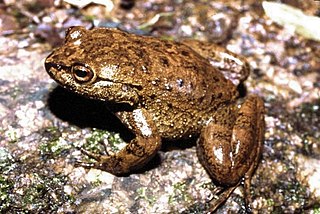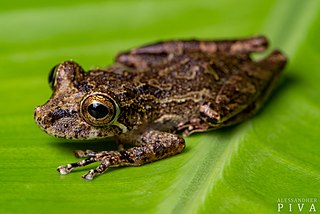
The saddleback toads (Brachycephalus) are a genus of tiny toads and frogs in the family Brachycephalidae in the order Anura, ranging from south Bahia to Santa Catarina in southeastern Brazil. The genus includes two main groups, the often brightly coloured pumpkin toadlets, and the overall brown and more frog-like flea frogs, which once were placed in their own genus Psyllophryne. Some pumpkin toadlets are toxic and their often bright colours are considered aposematic. At about 1 cm (0.4 in) or less in snout–to–vent length, the flea frogs are some of the smallest frogs in the world.

Physalaemus is a large genus of leptodactylid frogs. These frogs, sometimes known as dwarf frogs or foam frogs, are found in South America. It is very similar to Leptodactylus, a close relative, and indeed the recently described Leptodactylus lauramiriamae is in some aspects intermediate between them.

Leptodactylus is a genus of leptodactylid frogs. It includes the species commonly called ditch frogs or white-lipped frogs. It is very similar to Physalaemus, a close relative, and indeed the 2005 described Leptodactylus lauramiriamae is in some aspects intermediate between them.

Pseudopaludicola is a genus of leptodactylid frogs from lowland northern and central South America. They are known under the common name dwarf swamp frogs or swamp frogs.

Dendrophryniscus is a genus of true toads in the family Bufonidae, sometimes known as tree toads. They are endemic to the Atlantic Forest of Brazil.

Chiasmocleis is a genus of microhylid frogs. They are found in tropical South America north and east of the Andes. Their common name is humming frogs or silent frogs, the latter referring to the formerly recognized Syncope.

Boana is a genus of frogs in the family Hylidae. They are commonly known as gladiator frogs, gladiator treefrogs or Wagler Neotropical treefrogs. These frogs are distributed in the tropical Central and South America from Nicaragua to Argentina, as well as in the Caribbean.
Pithecopus ayeaye, also known as the reticulated leaf frog and reticulate leaf frog, is a species of frog in the subfamily Phyllomedusinae. It is endemic to Brazil. P. ayeaye is found in the transition zone between cerrado and Atlantic semi-deciduous forest, laying its eggs on leaves above streams or pools so the tadpoles, when hatched, fall into the water below. This species is under threat from habitat loss resulting from mining activity and fires, and is also affected by pollution from mining and pesticides. Its restricted range is likely to make it particularly vulnerable to these threats.

Hylodes is a genus of frogs in the family Hylodidae. The genus may be paraphyletic with respect to Megaelosia. The genus Hylodes is endemic to southeastern Brazil. Member species are also known commonly as the tree toads, or more ambiguously, as torrent frogs. They are diurnal and usually inhabit shallow mountain streams.
Proceratophrys concavitympanum is a species of frog in the family Odontophrynidae. It is endemic to Brazil and known from Rondônia, northwestern Mato Grosso, Pará, and Tocantins. It is the only Proceratophrys found in the Amazon rainforest.

Proceratophrys schirchi is a species of frog in the family Odontophrynidae. It is endemic to eastern Brazil and occurs in southeastern Bahia, Espírito Santo, northeastern Minas Gerais, and Rio de Janeiro states. The specific name schirchi honours Paulo F. Schirch, a Brazilian zoologist who collected the type series. Common names Santo smooth horned frog and Brazilian smooth horned frog can refer to this species, the latter specifically referring to Proceratophrys precrenulata that is now considered a junior synonym only.
Stereocyclops parkeri is a species of frog in the family Microhylidae. It is endemic to southeastern Brazil and known from the southwestern part of the state of Rio de Janeiro and from Ilha de São Sebastião ("Ilhabela"), São Paulo state. For a period it was treated as a synonym of Stereocyclops incrassatus, but is now recognized as valid species.

Phantasmarana is a genus of frogs in the family Hylodidae. The genus is endemic to the Atlantic Forest of southeastern Brazil.

Ololygon is a genus of frogs in the family Hylidae. The majority of species in it are endemic to the Atlantic Forest of eastern Brazil, although the range of some species, including Ololygon aromothyella and Ololygon berthae, is known to extend south to northeastern Argentina, southern Paraguay, and Uruguay.














